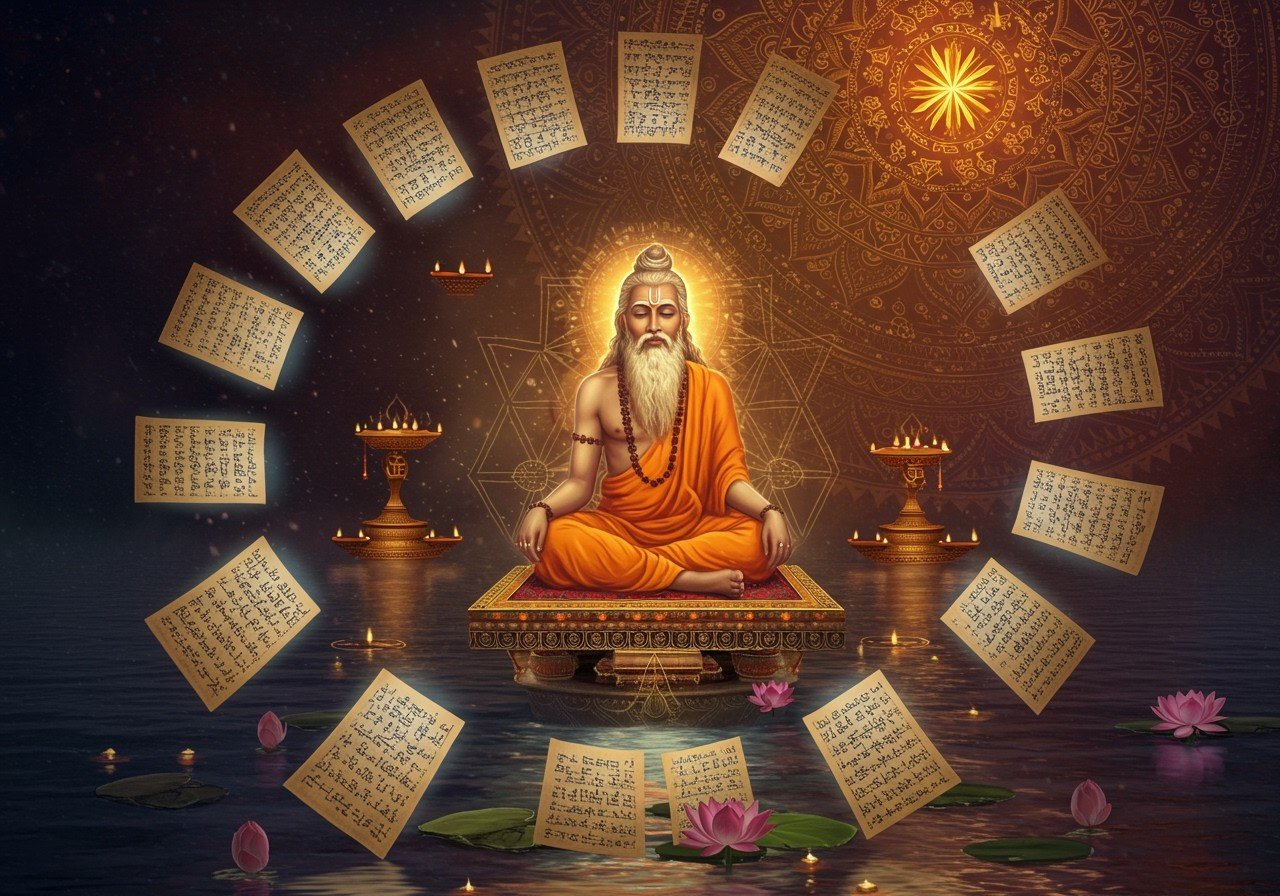
In the heart of ancient India, where the whispers of Vedic hymns still resonate, stands the revered figure of Sage Vamadeva. A prominent Rishi of the Rig Veda, his contributions to our spiritual heritage are immense. He gifted us not just sacred mantras, but also a profound understanding of Vedic rituals and Samhitas. These hymns, imbued with ancient wisdom, serve as a guiding light, illuminating our path towards spiritual understanding.
Vamadeva’s Hymns: A Symphony of Divine Connections
Imagine the scene centuries ago – a sage, deep in meditation, channeling divine inspiration into verses that would echo through time. Vamadeva, a respected Rishi in Hindu tradition, is renowned for his profound contributions to Mandala 4 of the Rig Veda. This Mandala, a treasure trove of spiritual wisdom, comprises 58 Suktas (hymns) with 589 verses, each carrying a unique vibration of ancient knowledge. Vamadeva’s devotion shines through as he praises Agni, the god of fire, followed by Indra and a host of other deities.
His family lineage deepens the mystical aura surrounding him. Born to Sage Gotama and brother to Nodhasa, he hails from a family steeped in Vedic tradition. Their collective wisdom enriches the Rig Veda, weaving a tapestry of knowledge across generations. It’s truly inspiring to think how Vamadeva, descending from the lineage of Sage Angiras, carried forward this rich heritage of spiritual understanding.
Vamadeva’s presence isn’t limited to the Rig Veda; his wisdom extends to the Brihadaranyaka and Aitareya Upanishads. These sacred texts hold him in high regard, showcasing his deep insights into spiritual matters. His teachings, transcending time, remain a beacon for those seeking spiritual enlightenment. He is indeed one of the greatest Rishi of Rig Veda.
Adding another dimension to his significance is Vamadeva’s connection to Lord Shiva. He is revered as one of the five faces of Shiva, embodying preservation, harmony, and beauty. This representation underscores his role in maintaining cosmic balance and nurturing divine aesthetics.
Vamadeva’s hymns are nothing short of masterpieces, rich in symbolism and esoteric meanings. They continue to ignite the spiritual spark in seekers today. When you chant his mantras or delve into his Samhitas, you can almost feel the resonance of ancient wisdom. Whether you seek enlightenment or a deeper connection with tradition, Vamadeva’s work offers a profound path.
Thanks to technology, these ancient texts are now readily available online. Digital formats, such as PDFs, bring Vamadeva’s hymns to your fingertips. Scholars have diligently translated and interpreted these texts, ensuring their essence remains accessible to modern readers, bridging the gap between tradition and the digital age.
Through his insightful exploration of divinity, nature, and human existence, Vamadeva’s teachings offer timeless guidance. They illuminate the cosmic order and our place within it. By embracing his wisdom, we not only honor our cultural heritage but also enrich our spiritual journey.
Poojn.in: Your Gateway to Sacred Ritual Items
At poojn.in, we understand the deep significance of connecting with our spiritual roots. That’s why we offer a curated selection of authentic puja items to support your practice of Vamadeva’s mantras and the study of Samhitas. You can explore our Puja Samagri collection for all your spiritual needs.
We offer:
- Original Sanskrit texts of Vamadeva’s mantras with accurate translations, allowing you to delve deeper into the meaning behind each sacred sound.
- High-quality ritual items for Vamadeva-related ceremonies, ensuring your practice is conducted with utmost reverence and authenticity. We also have a wide range of decorative items for your home and altar.
As India’s leading dashakarma bhandar, we prioritize quality and authenticity. Our online platform offers a convenient way to acquire everything you need for Vamadeva-related practices, delivered right to your doorstep.
Some of our essential items include:
- Copper Kalash and puja vessels, crafted with precision and reverence for traditional practices. We understand that these items are more than just tools; they are vessels of spiritual significance.
- Pure ghee for havan, ensuring the purity and sanctity of your sacred offerings. We source the finest ingredients to uphold the integrity of your rituals.
Visit www.poojn.in to discover our comprehensive selection or connect with our experts for personalized guidance.
Embracing Vamadeva’s Timeless Wisdom
Vamadeva’s words form a bridge between the past and present, connecting us to a timeless wisdom. His hymns and teachings flow like a sacred river, nourishing our souls and minds. By exploring his contributions to the Rig Veda and other sacred texts, we embark on a journey of self-discovery and spiritual awakening.
Vamadeva reminds us of the inherent harmony and beauty within and around us. Embracing his legacy is not just about honoring tradition; it’s about tapping into a source of inspiration that transcends time. Whether we chant his mantras or study his profound works, we engage with a heritage that enriches our lives immeasurably.
In this modern age, where tradition meets technology, Vamadeva’s teachings are more accessible than ever. Let us seize this opportunity to learn, grow, and keep the flame of ancient wisdom burning brightly within us.
Common Questions about Vamadeva’s Mantras and Samhitas
What is special about Vamadeva’s contribution to the Rig Veda? Vamadeva is credited with composing all 58 hymns in Mandala 4 of the Rig Veda, which consists of 589 verses. These hymns primarily focus on Agni, Indra, and other deities, reflecting the core beliefs of the Vedic period.
Who were Vamadeva’s family members? Vamadeva was the son of Sage Gotama and the brother of Nodhasa, both of whom were also associated with Rigvedic hymns. He is considered to be a descendant of Sage Angiras, a lineage known for its spiritual depth.
Where else is Vamadeva mentioned besides the Rig Veda? Vamadeva finds mention in other significant scriptures such as the Brihadaranyaka and Aitareya Upanishads, highlighting his influence across various Vedic texts. These mentions solidify his place as a prominent figure in ancient Indian spiritual thought.


